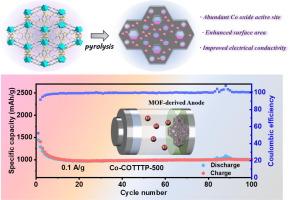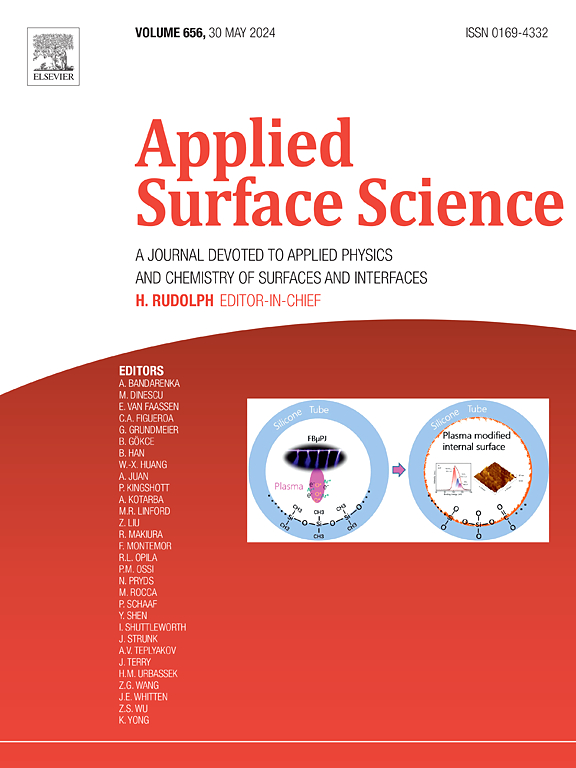基于环辛四硫噻吩的 MOF 衍生多孔材料作为锂离子电池的高性能负极
IF 6.3
2区 材料科学
Q2 CHEMISTRY, PHYSICAL
引用次数: 0
摘要
对能量密度更高的锂离子电池的巨大需求推动了对容量高于碳基材料的阳极的广泛研究。然而,高容量阳极的循环稳定性通常受到循环过程中显著的体积变化和结构崩溃的阻碍。金属有机框架(MOFs)是一类新兴的晶体材料,其衍生物具有易于官能化和孔隙工程的优点,有望成为高容量阳极的替代品。本研究通过热解无孔的共环八噻吩四吡啶(Co-COTTTP)模板,制备了一种新型多孔 Co-MOF 衍生复合阳极。X 射线吸收光谱和高分辨率透射电子显微镜显示,Co-COTTTP 衍生的复合阳极具有精确的组成,暴露出丰富的氧化还原钴活性位点、适当的石墨化程度以及 N、S 掺杂,从而有效地提高了复合阳极的电化学性能。因此,由此产生的多孔 MOF 衍生复合阳极在组装电池中表现出了高比容量和长循环稳定性。具体而言,使用 Co-COTTTP-500 阳极组装的电池在 0.1 A/g 条件下循环 100 次后可获得 1005.7 mAh/g 的高可逆比容量,并可在 1 A/g 条件下稳定循环 800 次,这表明电池在运行过程中结构稳定。总之,本研究为制备高性能 MOF 衍生阳极提供了一种可行的策略,并加深了对结构-活性关系的理解,有助于制备高能量密度的锂离子电池。本文章由计算机程序翻译,如有差异,请以英文原文为准。

Cyclooctatetrathiophene based MOF-Derived porous materials as High-Performance anode for Lithium-Ion batteries
Extensive research on anodes with higher capacity than carbon-based materials is driven by the great demand for lithium-ion batteries with higher energy density. However, the cycling stability of high-capacity anodes is usually hindered by significant volumetric changes and structural collapse during the cycling process. Metal-organic frameworks (MOFs) are an emerging class of crystalline materials, and their derivatives are expected as alternative high-capacity anodes, resulting from the merits of easy functionalization and pore engineering. In this study, a novel porous Co-MOF-derived composite anode was prepared by the pyrolysis of a nonporous Co-cyclooctatetrathiophene tetrapyridine (Co-COTTTP) template. X-ray absorption spectroscopy and high-resolution transmission electron microscopy revealed that the precise composition of Co-COTTTP-derived composite anodes with exposed rich redox cobalt oxides active sites, appropriate degree of graphitization, and N, S-doping, which effectively enhanced the electrochemical performance of the composite anodes. Thus, the resulting porous MOF-derived composite anode demonstrated high specific capacity and long cycling stability in the assembled batteries. Specifically, the cells assembled with Co-COTTTP-500 anodes delivered a high reversible specific capacity of 1005.7 mAh/g after 100 cycles at 0.1 A/g and can be cycled steady for 800 cycles at 1 A/g, indicating the structure stability during cell operation. In summary, this study provides a feasible strategy to prepare high-performance MOF-derived anodes and deep understanding for the structure–activity relationship, contributing to the fabrication of high-energy–density lithium-ion batteries.
求助全文
通过发布文献求助,成功后即可免费获取论文全文。
去求助
来源期刊

Applied Surface Science
工程技术-材料科学:膜
CiteScore
12.50
自引率
7.50%
发文量
3393
审稿时长
67 days
期刊介绍:
Applied Surface Science covers topics contributing to a better understanding of surfaces, interfaces, nanostructures and their applications. The journal is concerned with scientific research on the atomic and molecular level of material properties determined with specific surface analytical techniques and/or computational methods, as well as the processing of such structures.
 求助内容:
求助内容: 应助结果提醒方式:
应助结果提醒方式:


